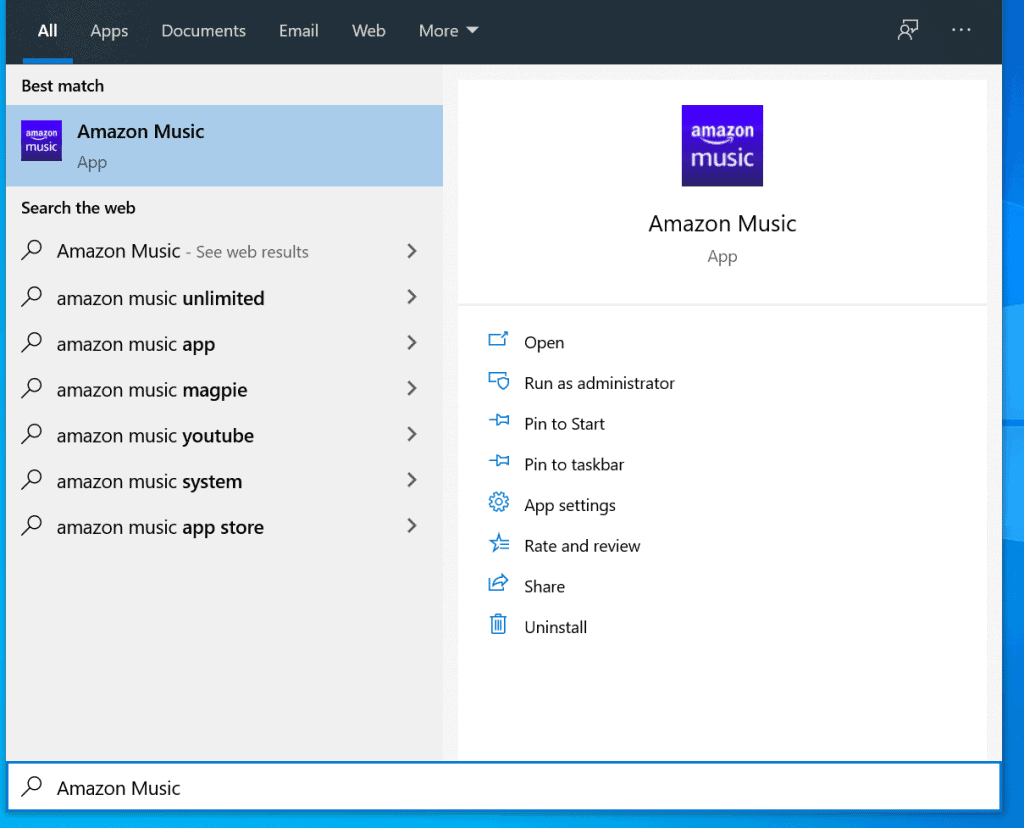
- Amazon music player for windows 10 how to#
- Amazon music player for windows 10 320 kbps#
- Amazon music player for windows 10 windows 10#
- Amazon music player for windows 10 Offline#
This service also has a feature that allows users to create playlists, and share them with friends. You can create playlists and share them with friends There is no ads displayed to interrupt user’s music experience.Ĥ. Users are able to store their music in the cloud, and listen to it anytime without any data connection. There are no ads and you can listen to music with or without a data connection This makes it easy for travelers who are without access to high speed internet connections and need music during their ride!ģ. This is a great way to save on data usage when traveling, as well as avoiding the hassles and costs of using Wi-Fi hotspots. You can download any song or album that you want to listen to offline.
Amazon music player for windows 10 Offline#
You can download songs to your device for offline listening This means that you can download or stream from your phone, tablet, desktop computer or laptop! Compatible with all operating systems (including Windows), this makes it easy to find the perfect listening experience for any situation.Ģ. The app is available from a multitude of devices, including Apple and Android. The Amazon Music player is available on all devices Instead the app simply give you a yellow logo indicating "HD" or "ULTRA HD".įrom what I can see, that's your only indication of stream quality.1. The playback application could (and probably should) display the bitrate of the source stream, but from what I can see on the web, the Amazon Music app doesn't.
Amazon music player for windows 10 how to#
So back to your original question, how to know what the bitrate of the source stream is It makes more sense for a DAC to display sample-rate - which is more meaningful in that you know if your audio data is at the long established norm of 44.1 kHz, or the "hi res" standards of 96 kHz or 192 kHz. They could be programmed to display the bitrate of the audio data they receive, but since they always receive uncompressed audio data, this is somewhat meaningless - all 16bit 44.1 kHz audio data will have the same bitrate - 1411 kbps. I stress that "HD" and "UHD" are Amazon's terms, not necessarily standard, or accepted, terms.ĭAC's are not playback devices, they never see the (compressed) source stream, so they can never show you the bitrate of the original stream. Samplerate will be from 44.1 kHz up to 192 kHz "UHD" - lossless compression stremas up to 3730 kbps bitrate.


"HD" - lossless compression (FLAC) streams up to 850 kbps bitrate.
Amazon music player for windows 10 320 kbps#
"SD" - lossy compression streams up to 320 kbps bitrate. I now realise you are mostly asking about bitrate, not samplerate. Under the last link I provided, see Which Amazon devices support Amazon Music HD? and Which home audio devices support Amazon Music HD? If you decide that Amazon Music HD (or Ultra HD) is your preferred service, consider getting a dedicated streamer to do the job instead, and free this task from your computer, which is far more useful for other things.
Amazon music player for windows 10 windows 10#
Personally I consider a Windows 10 computer complete overkill just to receive music streams, whether they be "HD" or not. Even if yours doesn't, you could borrow a DAC temporarily, just to check your setup. How to know what sample-rate is being delivered to the DAC? The only way to be 100% sure is to have a DAC which displays the sample-rate.

Is the Windows 10 Amazon Music desktop app capable of handling Amazon Music Ultra HD? Apparently yes, depending on the configuration of your DAC under Windows 10 -Ī: Amazon Music HD FAQs: Digital Music Control music playback to your device remotely from the Alexa app -Ī Help: Control Music Playback and Volume from the Alexa App


 0 kommentar(er)
0 kommentar(er)
